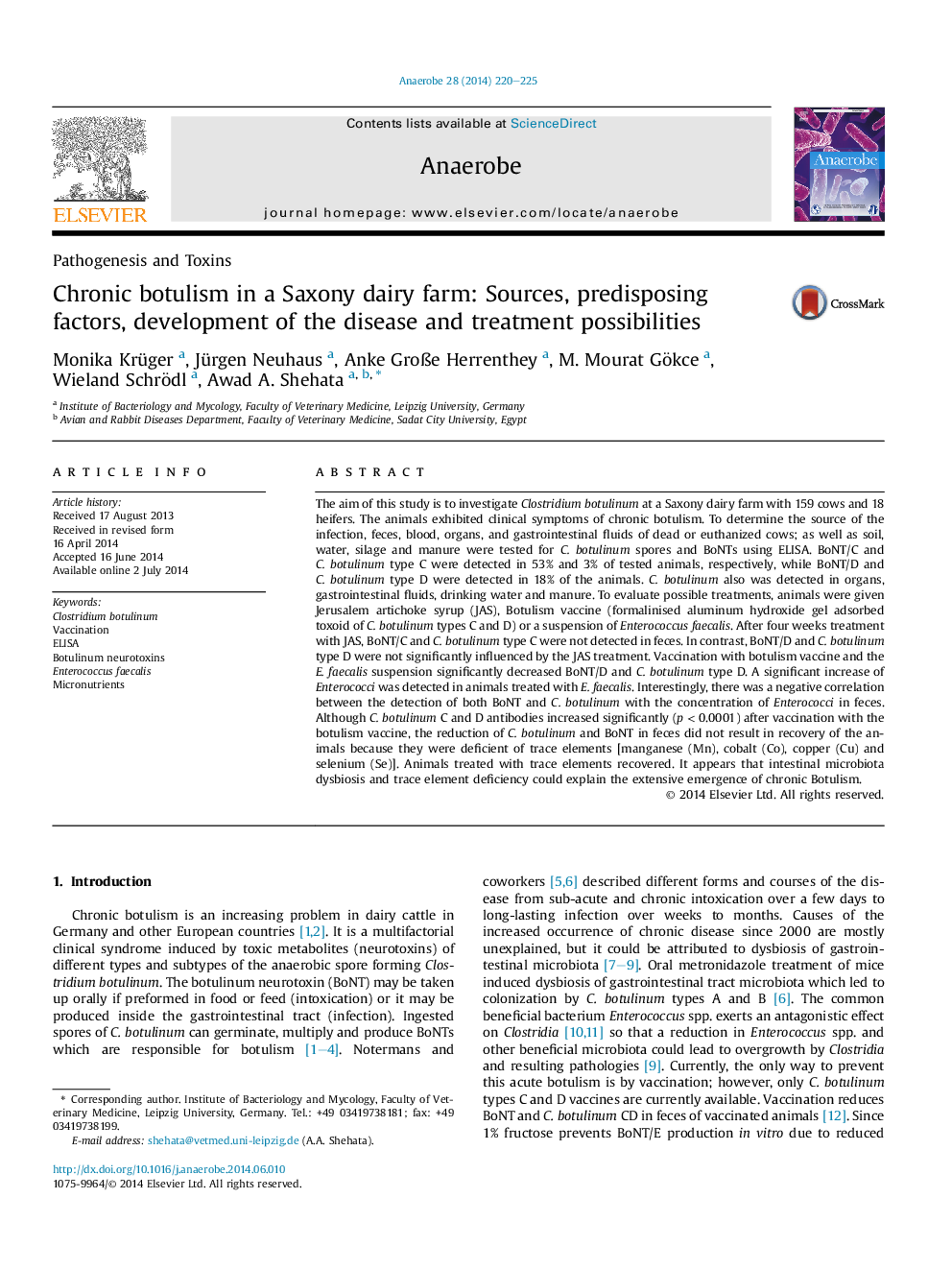| کد مقاله | کد نشریه | سال انتشار | مقاله انگلیسی | نسخه تمام متن |
|---|---|---|---|---|
| 6128735 | 1592835 | 2014 | 6 صفحه PDF | دانلود رایگان |
عنوان انگلیسی مقاله ISI
Chronic botulism in a Saxony dairy farm: Sources, predisposing factors, development of the disease and treatment possibilities
ترجمه فارسی عنوان
بوتولیسم مزمن در مزرعه لبنی ساکسونی: منابع، عوامل مستعد کننده، توسعه بیماری و امکانات درمان
دانلود مقاله + سفارش ترجمه
دانلود مقاله ISI انگلیسی
رایگان برای ایرانیان
کلمات کلیدی
موضوعات مرتبط
علوم زیستی و بیوفناوری
ایمنی شناسی و میکروب شناسی
میکروب شناسی
چکیده انگلیسی
The aim of this study is to investigate Clostridium botulinum at a Saxony dairy farm with 159 cows and 18 heifers. The animals exhibited clinical symptoms of chronic botulism. To determine the source of the infection, feces, blood, organs, and gastrointestinal fluids of dead or euthanized cows; as well as soil, water, silage and manure were tested for C. botulinum spores and BoNTs using ELISA. BoNT/C and C. botulinum type C were detected in 53% and 3% of tested animals, respectively, while BoNT/D and C. botulinum type D were detected in 18% of the animals. C. botulinum also was detected in organs, gastrointestinal fluids, drinking water and manure. To evaluate possible treatments, animals were given Jerusalem artichoke syrup (JAS), Botulism vaccine (formalinised aluminum hydroxide gel adsorbed toxoid of C. botulinum types C and D) or a suspension of Enterococcus faecalis. After four weeks treatment with JAS, BoNT/C and C. botulinum type C were not detected in feces. In contrast, BoNT/D and C. botulinum type D were not significantly influenced by the JAS treatment. Vaccination with botulism vaccine and the E. faecalis suspension significantly decreased BoNT/D and C. botulinum type D. A significant increase of Enterococci was detected in animals treated with E. faecalis. Interestingly, there was a negative correlation between the detection of both BoNT and C. botulinum with the concentration of Enterococci in feces. Although C. botulinum C and D antibodies increased significantly (p < 0.0001) after vaccination with the botulism vaccine, the reduction of C. botulinum and BoNT in feces did not result in recovery of the animals because they were deficient of trace elements [manganese (Mn), cobalt (Co), copper (Cu) and selenium (Se)]. Animals treated with trace elements recovered. It appears that intestinal microbiota dysbiosis and trace element deficiency could explain the extensive emergence of chronic Botulism.
ناشر
Database: Elsevier - ScienceDirect (ساینس دایرکت)
Journal: Anaerobe - Volume 28, August 2014, Pages 220-225
Journal: Anaerobe - Volume 28, August 2014, Pages 220-225
نویسندگان
Monika Krüger, Jürgen Neuhaus, Anke GroÃe Herrenthey, M. Mourat Gökce, Wieland Schrödl, Awad A. Shehata,
